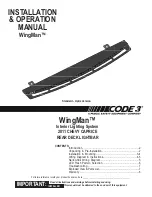
1987 Volvo 760
instrument panel and by a label near the filler inlet). U.S. and Canadian regulations require that pumps
delivering unleaded gasoline be labelled "UNLEADED". Only these pumps have nozzles which fit your
car's filler inlet. It is unlawful to dispense leaded fuel into a vehicle labelled "unleaded gasoline only".
Leaded gasoline damages the catalytic converter and the oxygen sensor system. Repeated use of leaded
gasoline will lessen the effectiveness of the emission control system and could result in loss of emission
warranty coverage. State and local vehicle inspection programs will make detection of misfueling easier,
possibly resulting in emission test failure for misfueled vehicles.
Octane Rating
Volvo engines require unleaded gasoline with an (R+M)/2 octane rating (also called the Anti-Knock
Index, or AKI) of 87 or higher. This is generally equivalent to a Research Octane Number (RON) of 91
or higher. For turbocharged engines, Volvo recommends the use of premium unleaded gasoline with an
(R+M)/2 rating of 91, for improved performance and driveability at high altitudes and in hot climates.
Detergent Or Injector Cleaning Gasoline
The use of specially formulated gasoline which contains so called "detergent" or "injector cleaning"
additives is allowed and recommended by Volvo. The use of these detergent additives in gasoline has
been shown to be effective in reducing the build up of certain injector deposits.
Gasoline Containing Alcohol
Some fuel suppliers sell gasoline containing alcohol without advertising the presence of alcohol. If you
are not sure whether there is alcohol in the gasoline you buy, check with the service station operator.
Blends of unleaded gasoline and ethanol (ethyl alcohol, grain alcohol), sometimes called "gasohol", are
available in some areas. Gasohol, if used, must contain no more than 10 percent ethanol and must have
an (R+M)/2 rating of 87 or higher. If you experience problems with starting, driveability, or fuel
economy with gasohol, you should discontinue its use.
Take care not to spill gasoline during refueling. Gasolines containing alcohol can cause damage to
painted surfaces, which may not be covered under the New Vehicle Warranty.
Do not use gasolines containing methanol (methyl alcohol, wood alcohol). This practice can result in
vehicle performance deterioration and can damage critical parts in the fuel system. Such damage may
not be covered under the New Vehicle Limited Warranty.
Refueling
The fuel tank filler cap is located behind the door on the left rear fender. Open cap slowly during hot
weather conditions.
When filling, position the cap in the special bracket on the door.
After filling the tank, install the cap and turn until a "click" is heard.
The fuel tank is designed to hold approximately 15.8 US gal. (60 liters), with sufficient volume left over
to accommodate possible expansion of the fuel in hot weather. When the gauge's needle enters the red
zone, approximately 2.4 US gal. (9 liters) of fuel remain in the tank.
Be aware that the "usable" tank capacity will be somewhat less than the 15.8-US gal. (60 liter)
maximum. When the fuel level is low, such factors as ambient temperature, the fuels "vapor pressure"
characteristics, and terrain can affect the fuel pumps' ability to supply the engine with an adequate
file:///K|/ownersdocs/1987/1987_760/87760_03.htm (3 of 21)12/30/2006 7:55:32 AM
















































